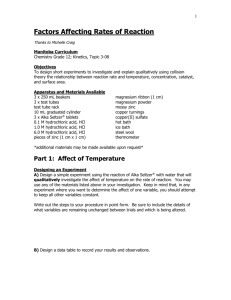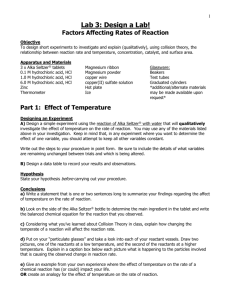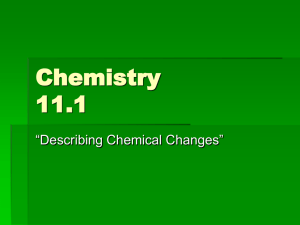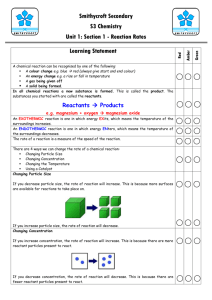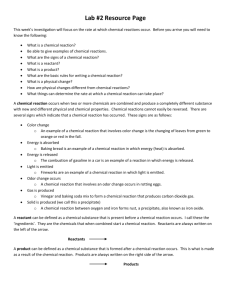Reaction Rates Lab: Temperature, Concentration, Catalysts
advertisement
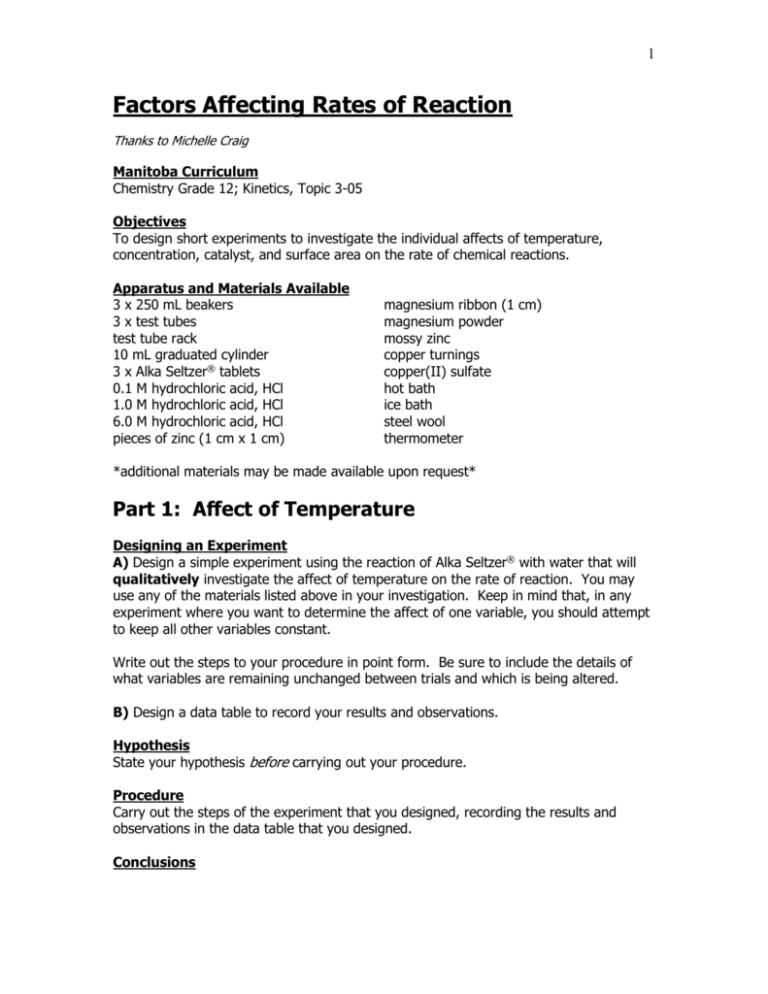
1 Factors Affecting Rates of Reaction Thanks to Michelle Craig Manitoba Curriculum Chemistry Grade 12; Kinetics, Topic 3-05 Objectives To design short experiments to investigate the individual affects of temperature, concentration, catalyst, and surface area on the rate of chemical reactions. Apparatus and Materials Available 3 x 250 mL beakers 3 x test tubes test tube rack 10 mL graduated cylinder 3 x Alka Seltzer® tablets 0.1 M hydrochloric acid, HCl 1.0 M hydrochloric acid, HCl 6.0 M hydrochloric acid, HCl pieces of zinc (1 cm x 1 cm) magnesium ribbon (1 cm) magnesium powder mossy zinc copper turnings copper(II) sulfate hot bath ice bath steel wool thermometer *additional materials may be made available upon request* Part 1: Affect of Temperature Designing an Experiment A) Design a simple experiment using the reaction of Alka Seltzer® with water that will qualitatively investigate the affect of temperature on the rate of reaction. You may use any of the materials listed above in your investigation. Keep in mind that, in any experiment where you want to determine the affect of one variable, you should attempt to keep all other variables constant. Write out the steps to your procedure in point form. Be sure to include the details of what variables are remaining unchanged between trials and which is being altered. B) Design a data table to record your results and observations. Hypothesis State your hypothesis before carrying out your procedure. Procedure Carry out the steps of the experiment that you designed, recording the results and observations in the data table that you designed. Conclusions 2 a) Write a statement that is one or two sentences long to summarize your findings regarding the affect of temperature on the rate of reaction. b) Look on the side of the Alka Seltzer® bottle to determine the main ingredient in the tablet and write the balanced chemical equation for the reaction that you observed. c) Considering what you’ve learned about Collision Theory in class, explain how changing the temperate of a reaction will affect the reaction rate. d) Put on your “particulate glasses” and take a look into each of your reactant vessels. Draw two pictures, one of the reactants at a low temperature, and the second of the reactants at a higher temperature. Explain in a caption box below each picture what is happening to the particles involved that is causing the observed change in reaction rate. ___________________________________ ___________________________________ ___________________________________ ___________________________________ ___________________________________ ___________________________________ ___________________________________ ___________________________________ e) Give an example from your own experience where the affect of temperature on the rate of a chemical reaction has (or could) impact your life. Eg) Hypothermia OR create an analogy for the affect of temperature on the rate of reaction. Part 2: Affect of Concentration Designing an Experiment A) Design a simple experiment using the reaction of zinc with hydrochloric acid that will qualitatively investigate the affect of concentration of the reactants on the rate of reaction. You may use any of the materials listed above in your investigation. Write out the steps to your procedure in point form. Be sure to include the details of what variables are remaining unchanged between trials and which is being altered. B) Design a data table to record your results and observations. Hypothesis State your hypothesis before carrying out your procedure. Procedure Carry out the steps of the experiment that you designed, recording the results and observations in the data table that you designed. 3 Conclusions a) Write a statement that is one or two sentences long to summarize your findings regarding the affect of concentration on the rate of reaction. b) Write the balanced chemical equation for the reaction that you observed. c) Considering what you’ve learned about Collision Theory in class, explain how changing the concentration of the reactants will affect the reaction rate. d) Put on your “particulate glasses” and take a look into each of your reactant vessels. Draw two pictures, one with the reactants at a low concentration, and the second of the reactants at a higher concentration. Explain in a caption box below each picture what is happening to the particles involved that is causing the observed change in reaction rate. ___________________________________ ___________________________________ ___________________________________ ___________________________________ ___________________________________ ___________________________________ ___________________________________ ___________________________________ e) Give an example from your own experience where the affect of concentration on the rate of a chemical reaction has (or could) impact your life. OR create an analogy for the affect of temperature on the rate of reaction. Eg) As the number of students in the hallways increase (i.e. during breaks) the number of collisions that occurs between the students increases. Part 3: Affect of Surface Area Designing an Experiment A) Design a simple experiment using the reaction of magnesium ribbon and magnesium powder with hydrochloric acid that will qualitatively investigate the affect of surface area of the reactants on the rate of reaction. You may use any of the materials listed above in your investigation. Write out the steps to your procedure in point form. Be sure to include the details of what variables are remaining unchanged between trials and which is being altered. B) Design a data table to record your results and observations. Hypothesis 4 State your hypothesis before carrying out your procedure. Procedure Carry out the steps of the experiment that you designed, recording the results and observations in the data table that you designed. Conclusions a) Write a statement that is one or two sentences long to summarize your findings regarding the affect of surface area of the reactants on the rate of reaction. b) Write the balanced chemical equation for the reaction that you observed. c) Considering what you’ve learned about Collision Theory in class, explain how changing the surface area of the reactants will affect the reaction rate. d) Put on your “particulate glasses” and take a look into each of your reactant vessels. Draw two pictures, one with the reactants with a small surface area, and the second of the reactants at a larger surface area. Explain in a caption box below each picture what is happening to the particles involved that is causing the observed change in reaction rate. ___________________________________ ___________________________________ ___________________________________ ___________________________________ ___________________________________ ___________________________________ ___________________________________ ___________________________________ e) Give an example from your own experience where the affect of surface on the rate of a chemical reaction has (or could) impact your life. Eg) Dissolving a clump of sugar in coffee versus dissolving granular sugar in coffee. OR create an analogy for the affect of surface area on the rate of reaction. Part 4: Affect of a Catalyst Designing an Experiment A) Design a simple experiment to determine if either copper turnings or copper (II) sulfate act as a catalyst in the reaction of zinc with hydrochloric acid. You may use any of the materials listed above in your investigation. Write out the steps to your 5 procedure in point form. Be sure to include the details of what variables are remaining unchanged between trials and which is being altered. B) Design a data table to record your results and observations. Hypothesis State your hypothesis before carrying out your procedure. Procedure Carry out the steps of the experiment that you designed, recording the results and observations in the data table that you designed. Conclusions a) Write a statement that is one or two sentences long to summarize your findings. b) Write the balanced chemical equation for the reactions that you observed. c) Explain why you would or would not consider copper (II) sulfate and copper turnings to be catalysts. d) Put on your “particulate glasses” and take a look into each of your reactant vessels. Draw two pictures, one with reaction with copper turnings, and the second of the reaction with copper (II) sulfate. Explain in a caption box below each picture what is happening to the particles involved that is causing the observed change in reaction rate. ___________________________________ ___________________________________ ___________________________________ ___________________________________ ___________________________________ ___________________________________ ___________________________________ ___________________________________ e) Give an example from your own experience where the affect of a catalyst on a chemical reaction has (or could) impact your life. Eg) the enzymes (biological catalysts) involved in digestion of the food you eat. OR create an analogy for the affect of a catalyst on the rate of reaction. Reference: Modified from: 6 Frankel, A. & Li, J. (1989) Chemistry: a second course. Don Mills, Ontario: AddisonWestley Publishers. (pp. 34-36)
